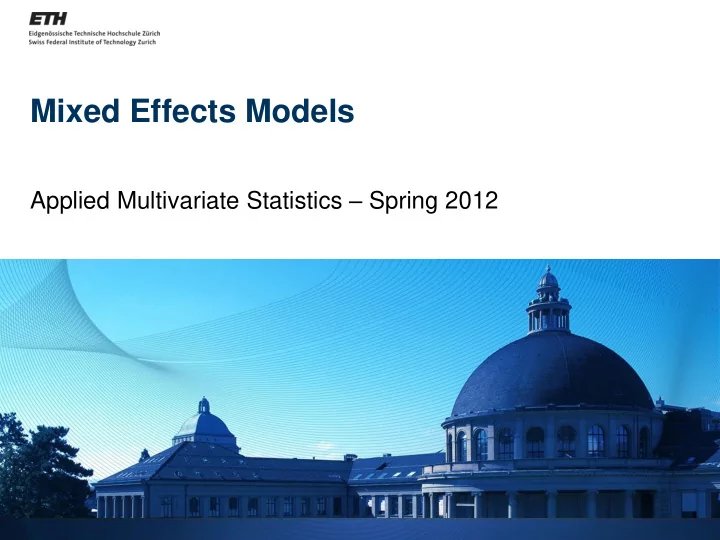

Mixed Effects Models Applied Multivariate Statistics – Spring 2012
Overview Repeated Measures: Correlated samples Random Intercept Model Random Intercept and Random Slope Model Case studies 1
Revision: Linear Regression Example: Strength gain by weight training For one person: ² j » N (0 ;¾ 2 ) i:i:d y j = ¯ 0 + ¯ 1 x j + ² j “fixed” effects 2
Several Persons: Repeated Measures Problem 1: Observations within persons are more correlated than observations between persons Problem 2: The parameters of each person might be slightly different 3
Weight Training revisited Each person has individual starting strength Each person has & individual starting strength response to training 4
Dealing with repeated measures Alternative 1: Block effects ² j » N (0 ;¾ 2 ) i:i:d y ij = ( ¯ 0 + ¯ 0 ;i ) + ¯ 1 x j + ² j Estimate: 𝛾 0 , 𝛾 0,𝑗 , 𝛾 1 , 𝜏 “fixed” effects Allows inference on individuals but not on population Alternative 2: Mixed effects (contains “fixed” and “random” effects) E.g.: Random Intercept model Fixed + Random y ij = ( ¯ 0 + u i ) + ¯ 1 x j + ² ij = ² ij » N (0 ; ¾ 2 ) ; u i » N (0 ; ¾ 2 u ) i:i:d Mixed “random” effects u i ; ² ij indep: “fixed” effects Estimate: 𝛾 0 , 𝛾 1 , 𝜏, 𝜏 𝑣 Allows inference on populations but not on individuals 5
Several Persons: Repeated Measures Problem 1: Observations within persons are more correlated than observations between persons Problem 2: The parameters of each person might be slightly different 6
Random Intercept Model implies correlated samples In Random Intercept Model, we do not explicitly model correlation of samples However, this is already implicitly captured in the model: V ar ( Y ij ) = ¾ 2 + ¾ 2 u Cov ( Y ij ; Y ik ) = ¾ 2 u Cov ( Y ij ;Y lk ) = 0 Within person, samples are correlated, between persons samples are uncorrelated Restriction: Correlation within person is the same for samples close or distant in time 7
Extending the Random Intercept Model: Random Intercept and Random Slope Model y ij = ( ¯ 0 + u i 1 ) + ( ¯ 1 + u i 2 ) x j + ² ij ² ij » N (0 ; ¾ 2 ) ; u i » MV N (0 ; §) i:i:d Estimate: 𝛾 0 , 𝛾 1 , 𝜏, Σ Similar calculations as before: V ar ( Y ij ) = ¾ 2 1 + 2 ¾ 12 x j + ¾ 2 2 x 2 j + ¾ 2 Cov ( Y ij ;Y ik ) = ¾ 2 1 + ¾ 12 ( x j + x k ) + ¾ 2 2 x j x k Cov ( Y ij ;Y lk ) = 0 More complex correlations within person is possible 8
Several Persons: Repeated Measures Problem 1: Observations within persons are more correlated than observations between persons Problem 2: The parameters of each person might be slightly different 9
Summary of models for repeated measures Block effect (using fixed effects): Allows inference on individuals but not on population Mixed effects: Allows inference on population but not on individuals - Random Intercept: Individually varying intercept Models constant correlation within person - Random Intercept and Random Slope: Individually varying intercept and slope Models varying correlation within person More complex models possible, but harder to fit 10
Estimation of mixed effects models Maximum Likelihood (ML): - Variance estimates are biased + Tests between two models with differing fixed and random effects are possible Restricted Maximum Likelihood (REML): Recommended + Variance estimates are unbiased for - Can only test between two models that have final model fit same fixed effects (default in R) P-values etc. using asymptotic theory 11
Model diagnostics Residual analysis as in linear regression: - Tukey-Anscombe Plot - QQ-Plot of residuals Additionally: Predicted random effects must be normally distributed, therefore - QQ-Plots for random effects 12
Mixed effects models in R Function “ lme ” in package “ nlme ” Package “lme4” is a newer, improved version of package “ nlme ”, but to me, it still seems to be under construction and therefore is not so reliable 13
Interpretation of output 1/2 y ij = (99 : 9 + u i 1 ) + (5 : 9 + u i 2 ) x j + ² ij ² ij » N (0 ; 1 : 97 2 ) ; u i » MV N (0 ; §) i:i:d 0.43 ∗ 1.54 2 ∗ 9.72 2 9.72 2 with Σ = 0.43 ∗ 1.54 2 ∗ 9.72 2 1.54 2 14
Interpretation of output 2/2 Using the function “intervals” for 95% confidence intervals: At first meeting, people lift on ave. 100 kg (95%-CI: 93-106) Per week people can lift 6 kg more (4.9-6.9) The stand.dev. of weights in first week is 10 (6-16) kg The stand.dev. in training progress is 1.5 (0.9-2.5) kg/week There is no clear connection btw. Typical deviation from weight in first week and training progress, fitted line is 2.0 (1.7-2.3) kg since CI of correlation covers 0. 15
Concepts to know Form of RI and RI&RS model and interpretation Model diagnostics 16
R functions to know Function “ lme ” in package “ nlme ” Functions: - “ groupedData ”, “ lmList ” - “intervals”, “ coef ”, “ ranef ”, “ fixef ” 17
Recommend
More recommend